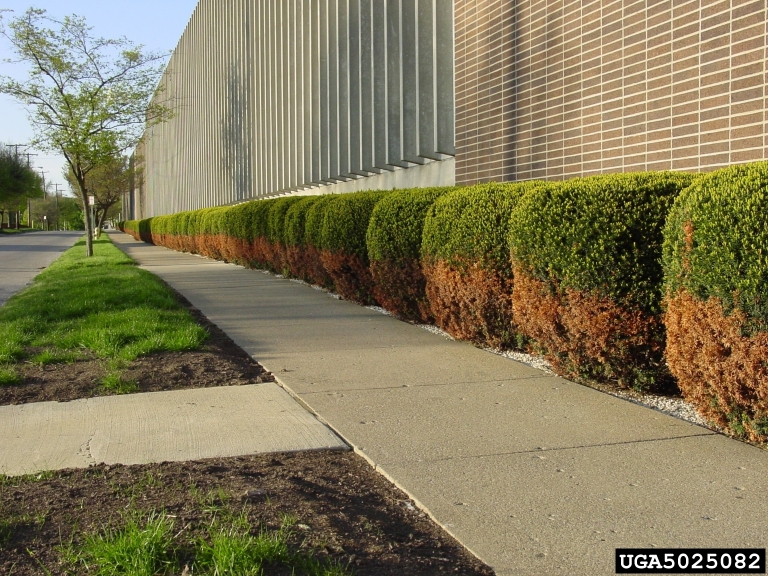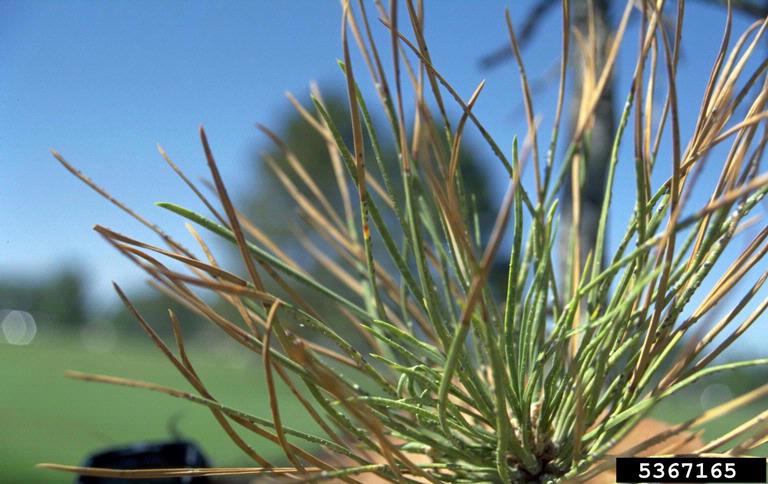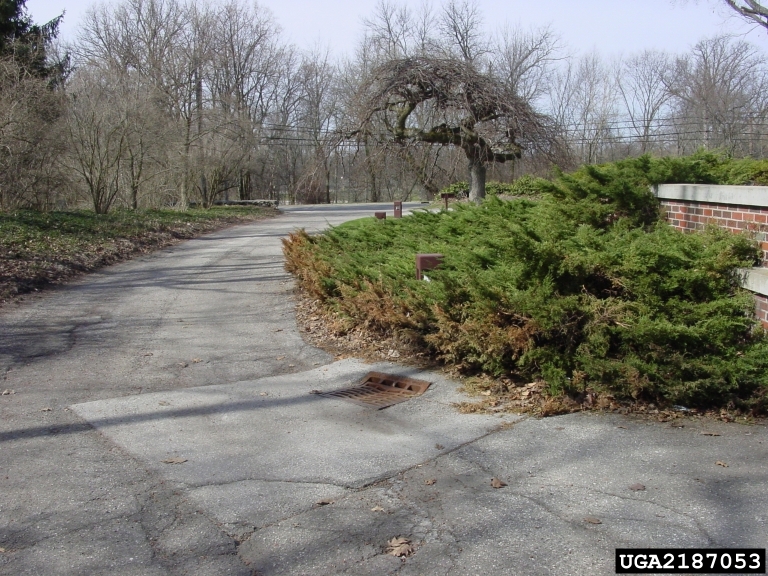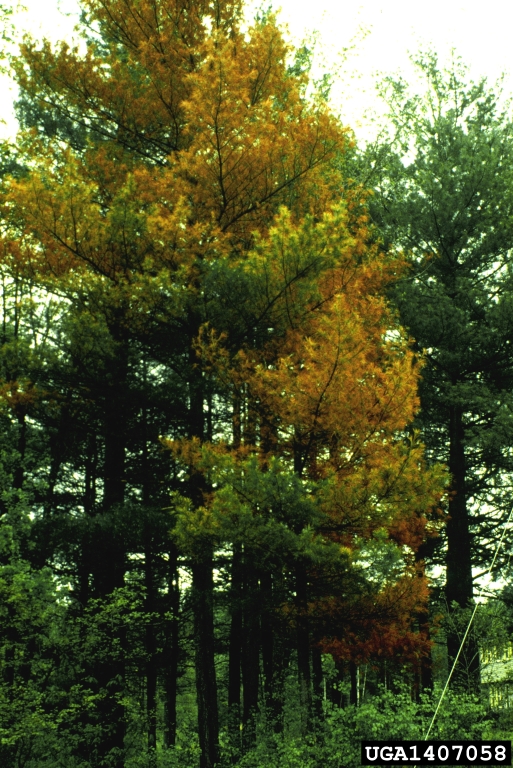
Salt – who knew something so delicious, could be so deadly? That’s right, salt can, and will, kill your plants. As winter rolls in, the salt rolls out onto our streets and sidewalks; but what makes winter safer for us makes it harmful to our plants. At RTEC, safety is our top priority. Still, the fact remains that the deicing rock salt used to protect your loved ones from slippery conditions is the same salt that can dissolve in the soil, trunk, branches, and leaves of your plants and damage them.
Lucky for you, we have some advice to help the plants in your landscape armor up and flourish next spring. And since we just had the first snow of the season, now is a great time to start protecting from the salt damage that may happen to your plants this winter.
What Is Salt Damage And Why Does It Happen?
Salt damage is when unnaturally large amounts of salt come into contact with plant material, ultimately disrupting the plant’s ability to function properly and resulting in harm. Salt hurts trees and shrubs in two ways; when it comes in contact with the above-ground portion of the plant, and when it enters the soil. When salt is splashed onto the trunk, bark, and leaves of a tree it can cause salt burn and pull the water out of the needles, buds, and branches leading to dehydration and the exposure of tender developing tissue.
Additionally, when salt enters the soil in high concentrations it will displace other nutrients in the soil and lead to the roots absorbing what is left, sodium and chloride. This will lead to nutrient deficiencies. In toxic levels, it will also cause leaf burn and dieback. In smaller concentrations, rock salt will pull water out of the tree’s roots dehydrating the tree even more; also known as Chemical Drought.
What’s In Deicing Salt & Why It’s Harmful To Trees And Shrubs
The most common rock salt used to melt ice and snow on roads and walkways is sodium chloride. Sodium chloride can have devastating impacts when it comes to the growth and overall health of trees and shrubs. It is harmful to plants because salt absorbs water, thus pulling water away from the roots and out of the plant’s tissues. Moreover, as the salt dissolves in the water, it splits into sodium ions and chloride ions – which affect the plant in different ways. The sodium ions reduce the plant’s ability to uptake essential nutrients such as potassium and magnesium. On the other hand, the chloride ions travel to the leaves, where they then interfere with photosynthesis. This combination diminishes the plant’s overall health and can result in a wide array of damage.

How To Tell If Your Plants Suffer From Salt Damage
If you have evergreens, you may have already started seeing signs of salt injury; however, if you have deciduous trees it’s possible you won’t be able to see the damage until growth continues in the spring.
According to the University of Massachusetts Amherst, here are common warning signs that salt may have damaged your plants:
- Damage mostly on the side of the tree facing roads, sidewalk, and driveway
- Browning or discoloration of needles beginning at tips
- Marginal Leaf Burn: Browning or discoloration along the edges of leaves.
- Fewer and/or smaller leaves than normal
- Flower and fruit development delayed/smaller than normal
- Bud damage/death
- Twig dieback
- Delayed bud break
- Reduced plant vigor
- Discolored foliage
- Early leaf drop or premature fall color
Trees Highly Susceptible to Rock Salt Damage:
- Red Maple
- Sugar Maple
- Boxwood
- Dogwood
- Black Walnut
- Norway Spruce
- Eastern White Pine
- Douglas Fir
- Pin Oak
- Littleleaf Linden
- Eastern Hemlock
Rock Salt Tolerant Trees:
- White Oak
- Northern Red Oak
- Paper Birch
- Colorado
- Spruce/Blue Spruce
- Juniper
- Mugo Pine

How To Care For Trees And Shrubs With Salt Damage
When salt damages plants, it can often come as a shock; the thought of rock salt damaging landscapes doesn’t typically cross people’s minds. If you have already noticed salt damage on your plants, don’t worry, there are steps you can take to help your plants recover from salt damage!
Rinse Your Trees: In the spring, once temperatures are above freezing, rinse off all trees and plants near salted roads, sidewalks, and driveways. Then water them thoroughly to dilute leftover rock salt. If you have evergreens, don’t forget to rinse their leaves.
Rinse The Soil: Often, road salt will be absorbed into the soil. To keep your plants from absorbing road salt chemicals all spring and summer, you need to flush out their soil. Water your trees and shrubs thoroughly to accomplish this. If there is any visible road salt, you can pick it up and throw it in the trash before you flush out the soil.
Lightly Prune: Remove dead twigs and needles from salt-damaged trees to help them start to spring healthier & happier.

How Bio-Stimulants Help Trees And Shrubs Recover From Salt Damage
One of the best ways to help salt-damaged trees & shrubs is by fertilizing them with bio–stimulants. They’re like multivitamins, but for plants, they’re all-natural and environmentally friendly! If you can get any program with RTEC, we recommend our bio-stimulants! They are beneficial to all trees and shrubs. Looking for a year-round plan? You can guide your plants to optimal health by signing up for our Canopy Protection Program. The program includes both bio-stimulant treatments and comprehensive solutions, all customized to your landscape’s needs.
Is Salt Damage Permanent?
It depends. Heavy salt damage can kill your trees and shrubs. If you take proper preventive measures and after-care steps, you give your plants a better chance of surviving! The snowy season is here, so let’s take a look at some tips to prevent salt damage before it begins.

How To Prevent Salt Damage
Don’t Use Salt: Pretty obvious, right? The easiest thing to do is to not lay down salt anywhere near your trees and landscape plants. If this will create a safety hazard on your property, then we have other solutions!
Choose Something Other Than Typical Rock Salt: If you can’t avoid placing salt near your trees, opt for calcium chloride, magnesium chloride, potassium chloride, or calcium magnesium acetate (CMA). These are more expensive than typical rock salt (Sodium Chloride) but are friendlier to trees and landscape plants.
Install A Barrier: If you don’t have control over what type of salt your plants are exposed to, install a barrier between your yard and roads/walkways that use salt. Try snow fencing or planting a barrier of salt-resistant trees. You can even use burlap or wood for a simpler barrier in a hurry.
Treat With Anti-Desiccants: Anti-desiccants form an invisible protective coating on leaves helping protect them from winter burn and rock salt damage. Click here to learn more about our Anti-Desiccants!

Work With A Certified Arborist To Protect Your Plants From Salt Damage
By teaming up with your Certified Arborist, you won’t only be able to fight against the damage salt has caused to your plants, but you’ll be able to help your plants reach their optimal health.
As winters become harsher and snowier in the Northern VA, DC, and Maryland areas, salt damage will become an increasing problem for trees and landscape plants. Make sure to protect your trees this winter. And keep in mind, if you see signs of salt damage on your tree in late winter/spring make an appointment to have one of our arborists check it out.
